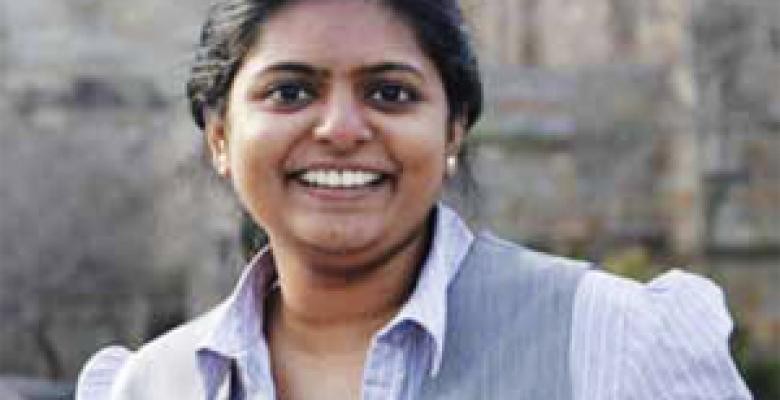Software Developer Combines Technology Skills With Journalism in New Dual-Degree Program

Over the course of a six-year career designing online banking software for the British financial firm HSBC, Rashmi Raman would often find herself trolling the Columbia Journalism School website and dreaming of the possibilities.
Back then, the idea that the 29-year-old programmer might actually quit her job in Bumi, India, and travel halfway around the globe to pursue a new career seemed beyond reach. Raman studied computer programming in college and had no formal journalism training.
“I was always passionate about journalism,” Raman says. “And I wanted to feel more involved—more committed to what I was going to be doing in the next few years. But I couldn’t give up computer science entirely—I’m a bit of a geek. So I was hesitant to apply.”
Then one day, Raman discovered a fresh posting on the J-school website that changed everything: a new dual-degree program that allows students to obtain a joint master of science in computer science and journalism. “I knew instantly it was the program I wanted to apply to,” she said.
This May, Raman, along with three other dual-degree candidates, will become one of the first graduates of the two-year program with Columbia Engineering that aims to teach professionals the technical aspects of both digital media and news production.
It is one of several ways the journalism school is plunging into the digital future. It launched the Tow Center for Digital Journalism in 2010, and last year set up the David and Helen Gurley Brown Institute for Media Innovation in partnership with Stanford Engineering. It also is playing a key role in Columbia’s new Institute for Data Sciences and Engineering.
For Raman, the program was the perfect mix of the old and the new, allowing her to continue to feed a passion for computer coding while embracing her desire to “be part of something where there is social consciousness and a significant impact.” Growing up in India, she saw how a vibrant free press helped transform her nation from an insular, developing economy stymied by red tape into a booming free market economy bursting with opportunity.
At Columbia, Raman was able to choose from a number of engineering electives and learn the realities of day-to-day journalism, producing a wide array of deadline stories and features on her assigned beat: small food businesses in New York City. She organized coding classes for other students, participated in hackathons—events in which computer programmers collaborate on software projects—and set up a student chapter of the Online News Association.
Her stories included an investigation into a New York City fraud-reduction program that required food stamp applicants to be fingerprinted. Raman accessed public databases to compare food stamp fraud rates in states without fingerprinting to those with it. She found no difference in the number of scams—a point soon validated by New York City officials themselves, when they reached the same conclusion and repealed the fingerprinting law on their own.
For her master’s thesis, Raman and a partner built an iPhone app geared to journalists. The app provides fields to collect information on sources interviewed, appends it to digital audio and picture files, creates a timeline of project reporting, and bundles them all together in a neat package easily accessible later on.
“Rashmi combines the curiosity of thought of a journalist with outstanding engineering skills,” said Emily Bell, the Tow Center’s director and a professor at the journalism school. “She and her cohort are wonderful examples of what we hoped the dual-degree program might produce.”
With graduation approaching, Raman is in the happy position of weighing different offers. She had originally thought she would become a technology reporter, but now hopes to build more tools for journalists. For example, one could allow journalists to verify if tweets are actually authentic. She said there is an emerging research area focused on developing algorithms that would allow computers to take raw data—like numbers from an earnings report or a baseball game—and churn out comprehensible, formulaic newspaper stories without the assistance of a journalist.
“I would love to be that person who people come to and say, ‘Hey, we need to build this and this is something involving technology,’ ” she says. “If I get the opportunity to write stories, I most definitely will but that is no longer my career objective. Once I got here, what I learned motivated me to try and do something innovative and potentially disruptive.”